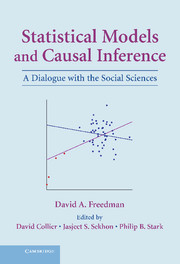Book contents
- Frontmatter
- Contents
- Preface
- Editors' Introduction: Inference and Shoe Leather
- Part I Statistical Modeling: Foundations and Limitations
- Part II Studies in Political Science, Public Policy, and Epidemiology
- Part III New Developments: Progress or Regress?
- 12 On Regression Adjustments in Experiments with Several Treatments
- 13 Randomization Does Not Justify Logistic Regression
- 14 The Grand Leap
- 15 On Specifying Graphical Models for Causation, and the Identification Problem
- 16 Weighting Regressions by Propensity Scores
- 17 On the So-Called “Huber Sandwich Estimator” and “Robust Standard Errors”
- 18 Endogeneity in Probit Response Models
- 19 Diagnostics Cannot Have Much Power Against General Alternatives
- Part IV Shoe Leather Revisited
- References and Further Reading
- Index
19 - Diagnostics Cannot Have Much Power Against General Alternatives
Published online by Cambridge University Press: 05 June 2012
- Frontmatter
- Contents
- Preface
- Editors' Introduction: Inference and Shoe Leather
- Part I Statistical Modeling: Foundations and Limitations
- Part II Studies in Political Science, Public Policy, and Epidemiology
- Part III New Developments: Progress or Regress?
- 12 On Regression Adjustments in Experiments with Several Treatments
- 13 Randomization Does Not Justify Logistic Regression
- 14 The Grand Leap
- 15 On Specifying Graphical Models for Causation, and the Identification Problem
- 16 Weighting Regressions by Propensity Scores
- 17 On the So-Called “Huber Sandwich Estimator” and “Robust Standard Errors”
- 18 Endogeneity in Probit Response Models
- 19 Diagnostics Cannot Have Much Power Against General Alternatives
- Part IV Shoe Leather Revisited
- References and Further Reading
- Index
Summary
Abstract. Model diagnostics are shown to have little power unless alternative hypotheses can be narrowly defined. For example, independence of observations cannot be tested against general forms of dependence. Thus, the basic assumptions in regression models cannot be inferred from the data. Equally, the proportionality assumption in proportional-hazards models is not testable. Specification error is a primary source of uncertainty in forecasting, and this uncertainty will be difficult to resolve without external calibration. Model-based causal inference is even more problematic.
Introduction
The object here is to sketch a demonstration that, unless additional regularity conditions are imposed, model diagnostics have power only against a circumscribed class of alternative hypotheses. The chapter is organized around the familiar requirements of statistical models. Theorems 1 and 2, for example, consider the hypothesis that distributions are continuous and have densities. According to the theorems, such hypotheses cannot be tested without additional structure.
Let us agree, then, that distributions are smooth. Can we test independence? Theorems 3 and 4 indicate the difficulty. Next, we grant independence and consider tests that distinguish between (i) independent and identically distributed random variables on the one hand, and (ii) independent but differently distributed variables on the other. Theorem 5 shows that, in general, power is lacking.
For ease of exposition, we present results for the unit interval; transformation to the positive half-line or the whole real line is easy.
- Type
- Chapter
- Information
- Statistical Models and Causal InferenceA Dialogue with the Social Sciences, pp. 323 - 334Publisher: Cambridge University PressPrint publication year: 2009

